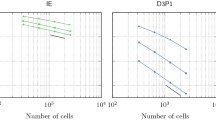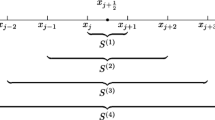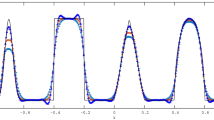The weighted essentially non-oscillatory (WENO) method is an excellent spatial discretization for hyperbolic partial differential equations with discontinuous solutions. However, the time-step restriction associated with explicit methods may pose severe limitations on their use in applications requiring large scale computations. An efficient implicit WENO method is necessary. In this paper, we propose a prototype flux-implicit WENO (iWENO) method. Numerical tests on classical scalar equations show that this is a viable and stable method, which requires appropriate time-stepping methods. Future study will include the examination of such methods as well as extension of iWENO to systems and higher dimensional problems.
Similar content being viewed by others
References
Gottlieb, S., and Mullen, J. S. (2003). An implicit WENO scheme for steady-state computation of scalar hyperbolic equations. In Bathe, K. J. (ed.), Computational Fluid and Solid Mechanics 2003.
Hairer, E., Nørsett, S. P., and Wanner, G. (1993). Solving Ordinary Differential Equations I – Nonstiff Problems, 2nd edn, Springer Series in Comput. Math. 8, Springer.
Harten A., Engquist B., Osher S., Chakravarthy S. (1987). Uniformly high order essentially non-oscillatory schemes I. SIAM J. Numer. Anal. 24, 279–309
Harten A., Engquist B., Osher S., Chakravarthy S. (1987). Uniformly high order essentially non-oscillatory schemes III. J. Comput. Phys. 71, 231–303
Jiang G.-S., Shu C.-W. (1996). Efficient implementation of weighted ENO schemes. J. Comp. Phys. 126, 202–228
LeVeque R.J. (1992). Numerical Methods for Conservation Laws Lectures in Mathematics Birkhauser, Basel
Liu X.-D., Osher S., Chan T. (1994). Weighted essentially non-oscillatory schemes. J. Comput. Phys. 115, 200
Shu C.-W. (2003). High order finite difference and finite volume WENO schemes and discontinuous Galerkin methods for CFD. Int. J. Comput. Fluid Dyn. 17, 107–118
Shu C.-W., Osher S. (1988). Efficient implementation of essentially non-oscillatory shock-capturing schemes. J. Comput. Phys. 77, 439–471
Author information
Authors and Affiliations
Corresponding author
Additional information
Sigal Gottlieb - The work of this author supported by NSF grant DMS-0106743.
Steven J. Ruuth - The work of this author was partially supported by a grant from NSERC Canada.
Rights and permissions
About this article
Cite this article
Gottlieb, S., Mullen, J.S. & Ruuth, S.J. A Fifth Order Flux Implicit WENO Method. J Sci Comput 27, 271–287 (2006). https://doi.org/10.1007/s10915-005-9034-z
Received:
Accepted:
Published:
Issue Date:
DOI: https://doi.org/10.1007/s10915-005-9034-z




